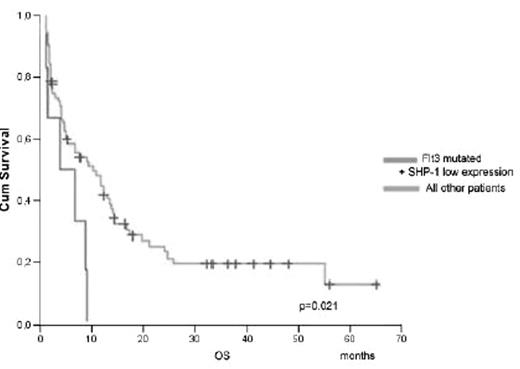Abstract
Recently, Chen et al (
J Biol Chem.2005;280:5361–9
) showed SHP-1 (PTPN6) gene supression by FLT3/ITD in TF-1 cell lines and in primary cells from AML patients. To address the prognostic impact that both together FLT3/ITD and SHP-1 gene suppression may have in myeloid malignancies patients, we have studied 85 patients diagnosed with de novo AML and MDS. SHP-1 gene expression was quantified by real time PCR and compared with normal CD34+ cells from healthy donors. FLT3/ITD was detected by conventional agarose gel electrophoresis after PCR. FLT3/D835 was detected by melting curve methodology. FLT3 mutations were correlated with higher WBC and blasts count at diagnosis (p=0.001). FLT3/ITD had a negative impact on DFS compared with wt or D835 mutations (log-rank p=0.054). Median levels for SHP-1 were lower in leukemic blasts than in normal peripheral blood CD34+ cells (p=0.001). SHP-1 lowest expression was found in those patients where FLT3 mutations were present (p=0.001). SHP-1 lowest expression was associated with higher blasts count in BM at diagnosis (p=0.017).Having both Flt3 mutations and lowest expression for SHP-1 were strongly associated with higher WBC (> 20 x109/L) (p=0.005). OS univariate analysis yielded a worse prognosis for patients having both lower SHP-1 expression and harboring an Flt3 mutation (p=0.021).
In summary, SHP-1 (PTPN6) gene supression by FLT3 constitutively activating mutations confers a bad prognosis for myeloid malignancies patients and is associated with hyperleukocytosis at diagnosis.
Disclosure: No relevant conflicts of interest to declare.
Author notes
*
Corresponding author
2006, The American Society of Hematology
2006



This feature is available to Subscribers Only
Sign In or Create an Account Close Modal